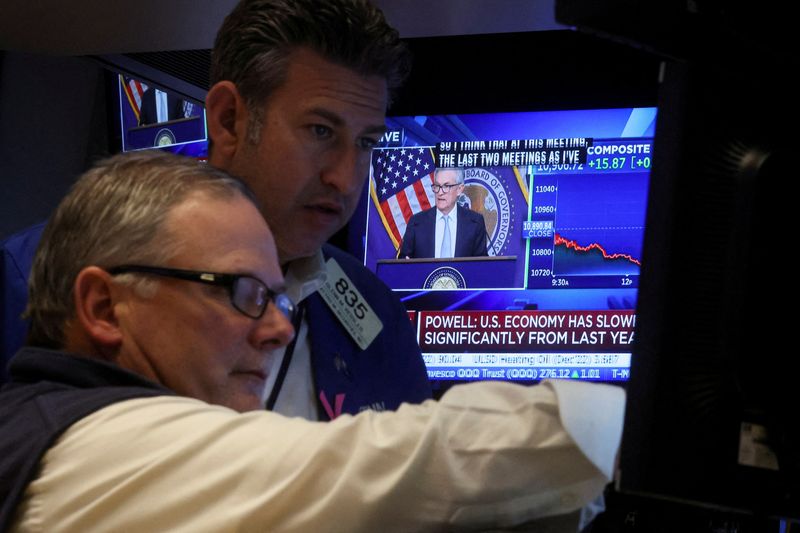A look at the day ahead in U.S. and global markets from Mike Dolan
With U.S. stocks at new records and devastating Hurricane Milton now weakening as it passes over Florida, the shifting U.S. interest rate horizon is back in focus with September’s key inflation update due on Thursday.
Despite the stormy weather and Middle East anxiety, U.S. economic soundings remain robust and Federal Reserve easing expectations continue to be dialled back – sending the dollar to near two month highs in the process.
With the U.S. economy estimated to be still expanding at more than 3%, markets now seeing little more than an 80% chance of another Fed rate cut next month and the whole rate futures curve has backed up some 50 basis points over the past month.
That puts a notional Fed ‘terminal rate’ closer to 3.5% – well above the 2.9% long-term ‘neutral’ rate Fed policymakers indicated at their last meeting.
Minutes of that meeting late Wednesday showed a “substantial majority” of officials supported a half-point rate cut to start the easing cycle, but there appeared to be agreement the first move would not commit the Fed to any particular pace thereafter.
A stream of Fed speakers this week seem to back that up.
“Two more cuts this year, or one more cut this year, really spans the range of what is likely in my mind,” San Francisco Fed boss Mary Daly said overnight.
After a lacklustre 10-year Treasury note auction on Wednesday, 10-year yields climbed to their highest since July and both two and 10-year yields have now got a foothold back above 4%.
Perhaps more concerning for the Fed is creeping market inflation expectations, with so-called ‘breakeven’ expectations from the 10-year inflation-protected securities markets rising to near three-month highs at 2.3% – nearly 30 basis points higher than they were a month ago.
And more worryingly ahead of next month’s election, the U.S. Treasury 10-year term premium, a measure of the compensation investors demand to hold long-term government debt securities, moved back into positive territory this week.
That spins attention into today’s critical consumer price report, where headline annual CPI inflation is expected to ease to 2.3% – its lowest in more than three years – but with ‘core’ inflation stickier around 3.2%.
“I continue to see a meaningful risk that inflation could get stuck above our 2% goal,” Dallas Fed chief Lorie Logan said on Wednesday, adding that the Fed “should not rush to reduce the fed funds target to a ‘normal’ or ‘neutral’ level”.
Even though energy markets remain nervous about widely-expected Israeli retaliation against Iran for its recent rocket attacks on the country, oil prices have stayed relatively calm on Thursday and hovered just above $74 per barrel.
Oil prices continue to track year-on-year losses of more than 10%, a powerful base effect weighing on headline inflation, and U.S. retail pump prices remain at 8-month lows.
With the third-quarter U.S. earnings season about to unfold with the big banks reporting on Friday, there was little in the Fed rethink that seemed to hold U.S stocks back and the raced 0.7% higher on Wednesday to new highs.
Emboldened by the higher interest rate horizon alongside much reduced fears of recession, banks and financial stocks led the latest leg higher and corporate credit spreads tightened.
With the S&P500 now up 21.4% for the year to date, Deutsche Bank analysts point out that this is strongest performance for the index at this point of any year since 1997.
Stock futures held the bulk of the latest gains on Thursday ahead of the CPI report, only marginally in the red ahead of today’s bell.
Overseas markets were similarly buoyant, with China’s recently volatile stock indexes catching a break after the early week retreat on doubts about the efficacy of the Beijing’s latest economic stimulus measures.
Mainland and Hong Kong markets advanced between 1-3% as the People’s Bank of China kicked off a swap programme aimed at supporting the stock market, while investors await directions from further detailed fiscal policy announcements this weekend.
With one eye on the French government’s 2025 budget later on Thursday – which is set to deliver some 60 billion euros ($65.68 billion) worth of tax hikes and spending cuts to tackle the fiscal deficit – European stocks underperformed and dropped 0.5%. The euro fell to its lowest in a month.
With weak sales being reported in China, European automakers continue to suffer.
pushed higher, however, with the yen briefly hitting its weakest level against the dollar since early August.
Warren Buffett’s Berkshire Hathaway (NYSE:), meantime, has raised 281.8 billion yen ($1.9 billion) in a yen-denominated bond offer, a move analysts say lays the ground for the U.S investment company to increase its exposure to Japanese assets.
In company news, GSK jumped about 6% in London after the British drugmaker agreed to pay up to $2.2 billion to settle U.S. lawsuits that claimed its discontinued heartburn drug Zantac caused cancer. The figure was smaller than what some analysts had feared.
Key developments that should provide more direction to U.S. markets later on Thursday:
* US September consumer price inflation, weekly jobless claims
* Federal Reserve Board Governor Lisa Cook, New York Fed President John Williams and Richmond Fed chief Thomas Barkin all speak

* US corporate earnings: Delta Airlines (NYSE:), Domino’s Pizza (NYSE:)
* US Treasury auctions $22 billion of 30-year bonds
(By Mike Dolan, editing by Philippa Fletcher; mike.dolan@thomsonreuters.com)


